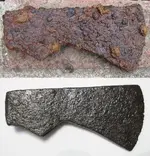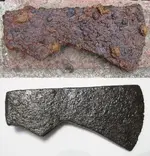Don in SJ
Silver Member
- Joined
- May 20, 2005
- Messages
- 4,937
- Reaction score
- 852
- Golden Thread
- 0
- Detector(s) used
- MINELAB SE Pro
- Primary Interest:
- All Treasure Hunting
First went on an exploring trip for an hour or so, to no avail, so I finished up my hunt at the site that in March and April has yielded 5 KG coppers and 2 NJ coppers and several buttons and cufflinks. I had to really beat the bush to hit areas that I previously barely touched and it did pay off.
My first target was this octagonal shaped button, which usually are part of cufflinks so I will call it such, it is of a white metal, and has a floral petal design on it.
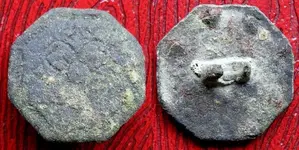
Next target was a raised boss type button, not a tombac, another indicator of an old site.
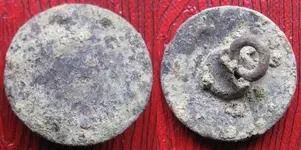
I then got a nice reading against the base of a big oak tree, after some struggle with roots a small flat pin appeared, at the time I had no idea it was a pin but upon cleaning it is very obvious it was a pin, with a decent design and again period of the homestead.
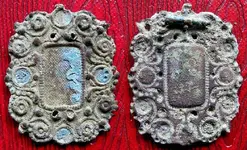
Finally, I got a funky reading near the base of a Holly tree, they are always fun to dig under (NOT) and I was not sure it was iron, since I was getting a varied reading, of course I was hoping it was a coin next to iron, but about 10-12 inches down I struck a piece of iron, now Holly roots can be a game stopper at times and if I would have been more tired, I might have left this piece of iron in the ground for another day, but since I was not finding the typicial pieces of iron pot, I thought perhaps this might be some other iron relic, or maybe even an entire iron pot!
I kept cutting roots and finally got around to the edges of it and saw that I could move it, so now I was going to get it out no matter what. I am sure glad I persisted since when I saw that axe come out of the hole, I felt like I just completed a successful hunt! I knew by the shape it was going to be my oldest axe found and without a doubt my first 1700 era one.
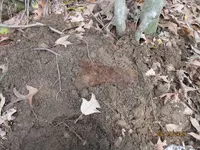
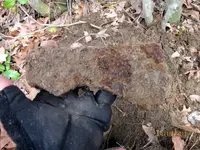
I got home washed dirt off the axe and shot some photos.
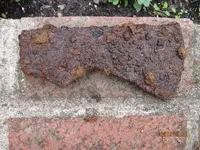
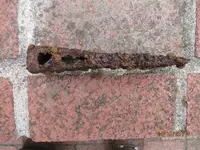
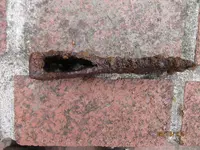
When I got inside I got out my book on American Revolution relics out and sure enough it matched one of the ones pictured in the book by Neumann and Kravic. So I did find my first Colonial Axe. With it being 7 inches in length, cannot call it a belt axe but a "Felling Axe" would be more proper, one used mainly for cutting down trees, although it is on the small end of that scale.
As I was photograhing the washed off Axe, I noticed there is a square nail that must have been used as the wedge to hold the axe in the wooden handle, so rather cool having that still with the axe head......
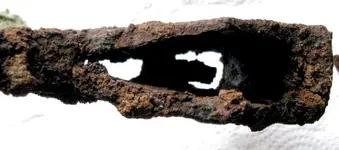
Overall, that little homestead was very good to me, with 7 colonial coins and numerous buttons, couple cufflinks and of course the Axe! Oh, also got 2 Wheaties while doing my one hour exploration hike.
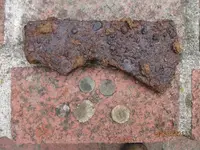
UPDATE:After a couple days of electrolysis, then soaking in distilled water for a day, dried in a toaster oven for a few hours, then did 3 light coats of Crisco oil and it came out a bit better than found. I really wanted to try Flaxseed Oil on this but had none, so decided to go ahead and use Crisco which is what I used previously on two trivets and two irons with decent success.....
I really wanted to try Flaxseed Oil on this but had none, so decided to go ahead and use Crisco which is what I used previously on two trivets and two irons with decent success.....
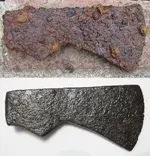
Don
My first target was this octagonal shaped button, which usually are part of cufflinks so I will call it such, it is of a white metal, and has a floral petal design on it.

Next target was a raised boss type button, not a tombac, another indicator of an old site.

I then got a nice reading against the base of a big oak tree, after some struggle with roots a small flat pin appeared, at the time I had no idea it was a pin but upon cleaning it is very obvious it was a pin, with a decent design and again period of the homestead.

Finally, I got a funky reading near the base of a Holly tree, they are always fun to dig under (NOT) and I was not sure it was iron, since I was getting a varied reading, of course I was hoping it was a coin next to iron, but about 10-12 inches down I struck a piece of iron, now Holly roots can be a game stopper at times and if I would have been more tired, I might have left this piece of iron in the ground for another day, but since I was not finding the typicial pieces of iron pot, I thought perhaps this might be some other iron relic, or maybe even an entire iron pot!
I kept cutting roots and finally got around to the edges of it and saw that I could move it, so now I was going to get it out no matter what. I am sure glad I persisted since when I saw that axe come out of the hole, I felt like I just completed a successful hunt! I knew by the shape it was going to be my oldest axe found and without a doubt my first 1700 era one.


I got home washed dirt off the axe and shot some photos.



When I got inside I got out my book on American Revolution relics out and sure enough it matched one of the ones pictured in the book by Neumann and Kravic. So I did find my first Colonial Axe. With it being 7 inches in length, cannot call it a belt axe but a "Felling Axe" would be more proper, one used mainly for cutting down trees, although it is on the small end of that scale.
As I was photograhing the washed off Axe, I noticed there is a square nail that must have been used as the wedge to hold the axe in the wooden handle, so rather cool having that still with the axe head......

Overall, that little homestead was very good to me, with 7 colonial coins and numerous buttons, couple cufflinks and of course the Axe! Oh, also got 2 Wheaties while doing my one hour exploration hike.

UPDATE:After a couple days of electrolysis, then soaking in distilled water for a day, dried in a toaster oven for a few hours, then did 3 light coats of Crisco oil and it came out a bit better than found.
 I really wanted to try Flaxseed Oil on this but had none, so decided to go ahead and use Crisco which is what I used previously on two trivets and two irons with decent success.....
I really wanted to try Flaxseed Oil on this but had none, so decided to go ahead and use Crisco which is what I used previously on two trivets and two irons with decent success.....
Don
Amazon Forum Fav 👍
Upvote
0







 The pin is a different find as well not much stuff like that turns up here for me.
The pin is a different find as well not much stuff like that turns up here for me.
